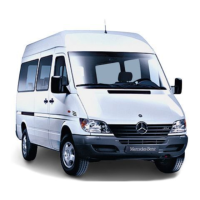#
Alwayspay careful attention to thetraf‐
ficsituation; do notrelyonActiveBrake
Assist alone. ActiveBrake Assist is only
an aid. The driver of thevehicle is
responsible forkeeping asufficiently
safedistance to thevehicle in front, for
vehicle speed and forbraking in good
time.
#
Be preparedtobrake or swerve if nec‐
essary.
Also observe thesystemlimitations of Active
BrakeAssist.
The individualsubfunctions areavailable in
thefollowing speed ranges:
Distance warning function
The distance warning function warnsyou at
speeds greater than approximately4mph
(7 km/h), if your vehicle is critically close to a
vehicle or pedestrian.
An intermittent warning tone sounds and the
· distance warning lamplightsupinthe
instrument cluster.
Brakeimmediately or take evasiveaction, provi‐
ded it is safetodosoand thetraffic situation
allows this.
Thedistance warning function can aid youinthe following situations withanintermittent warn‐
ing tone and awarninglamp:
Vehicles travel‐
ing in front
Stationaryvehi‐
cles
Crossing vehi‐
cles
Crossing pedes‐
trians/cyclists
Stationary
pedestrians
Up to approx.
155mph
(250 km/h)
Up to approx.
124mph
(200 km/h)
No reaction Up to approx.
37 mph
(60 km/h)
No reaction
Autonomous braking function
The autonomous braking function mayintervene at speeds starting from approximately 4mph
(7 km/h)inthe following situations:
Vehicles travel‐
ing in front
Stationaryvehi‐
cles
Crossing vehi‐
cles
Crossing pedes‐
trians/cyclists
Stationary
pedestrians
Up to approx.
155mph
(250 km/h)
Up to approx.
124mph
(200 km/h)
No reaction Up to approx.
37 mph
(60 km/h)
No reaction
Situation-dependent braking assistance
Situation-dependent braking assistance mayintervene at speeds starting from approximately
4mph (7 km/h) in the following situations:
Vehicles travel‐
ing in front
Stationaryvehi‐
cles
Crossing vehi‐
cles
Crossing pedes‐
trians/cyclists
Stationary
pedestrians
Up to approx.
155mph
(250 km/h)
Up to approx.
50 mph
(80 km/h)
No reaction Up to approx.
37 mph
(60 km/h)
No reaction
Drivingand parking
141

